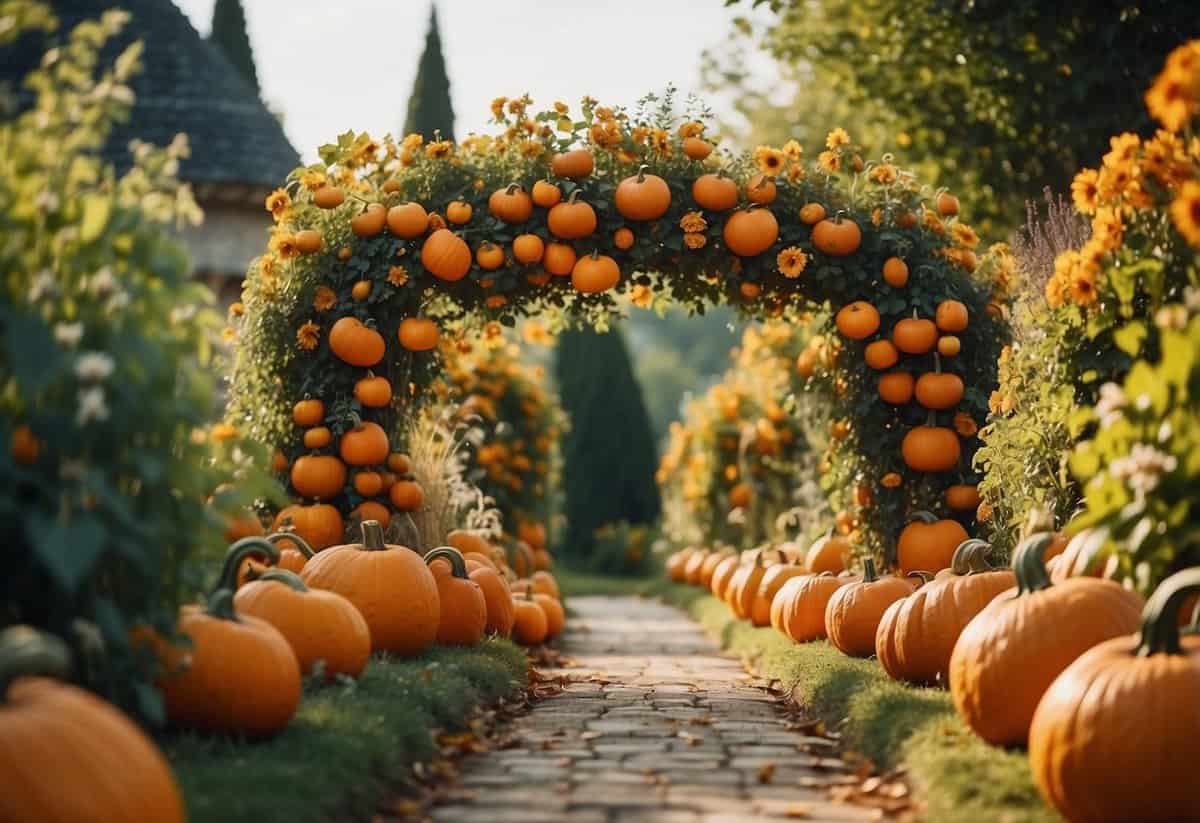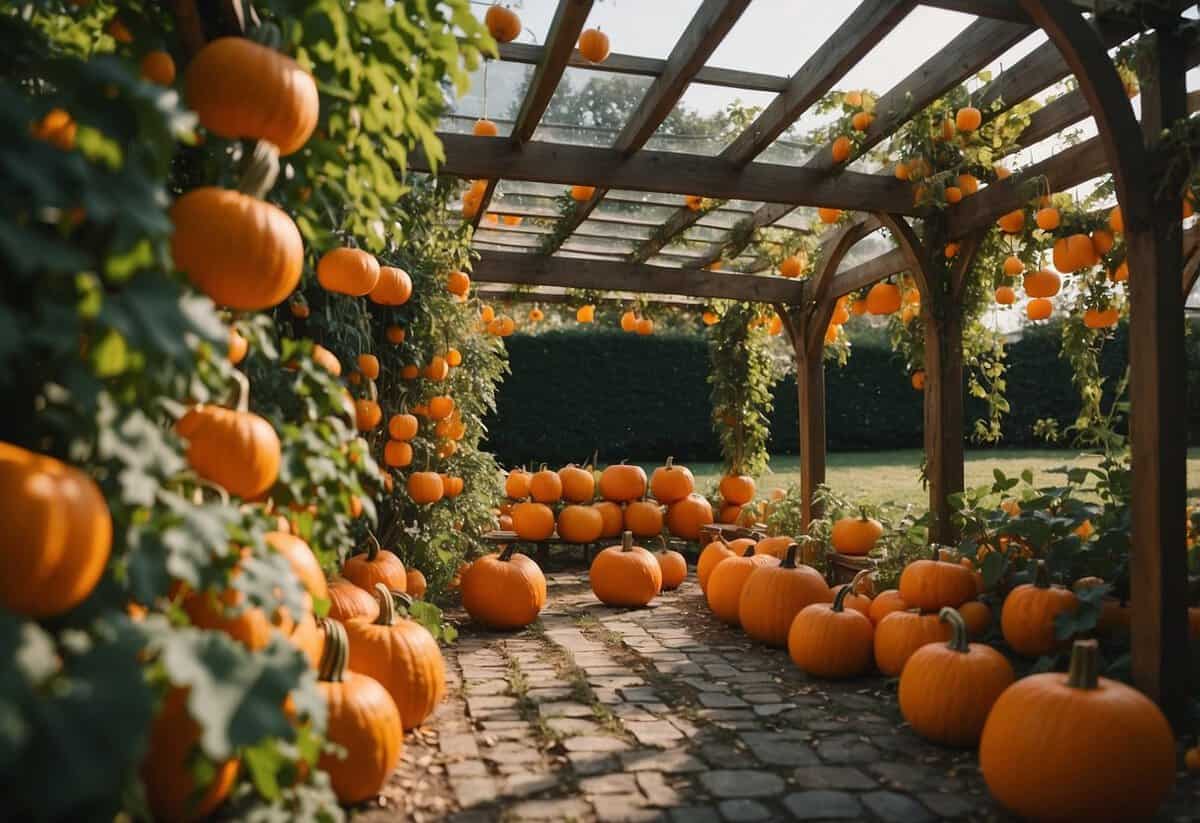Pumpkin Garden Ideas: Fun and Creative Ways to Grow Your Own Patch
Pumpkin gardens are a wonderful way to bring a touch of autumn to your backyard. From small plots to larger areas, the design possibilities are endless and can fit any space you have. These gardens not only produce delicious pumpkins but also add beauty and charm to your outdoor space.

Whether you are a seasoned gardener or just starting out, there are plenty of creative ways to grow pumpkins. With the right tips and ideas, you can enjoy a bountiful harvest and the satisfaction of growing your own pumpkins.
1) Fairy Tale Pumpkin Arch

Creating a Fairy Tale Pumpkin Arch transforms your garden into a magical place. Imagine walking under an arch covered in lush pumpkin vines and enchanting flowers. It’s easier than you might think!
Start by building a simple trellis arch. This arch will give the pumpkin vines a place to grow vertically. This not only saves space but creates a stunning visual.
Decorate the arch with fairy lights and small hanging ornaments. You can use miniature pumpkins and little fairy figurines to add a whimsical touch. This adds charm and magic to your garden pathway.
2) Pumpkin Tower Centerpiece

Creating a pumpkin tower centerpiece is a fun way to showcase fall decor. You can stack different sizes of pumpkins to make a striking display.
First, gather foam pumpkins and cut slits in the top and bottom of each one. This allows a rod or paper towel holder to pass through the center, making the tower sturdy.
Next, start threading the pumpkins onto the rod. Mix and match colors for a vibrant look. You can add small decorations like leaves or flowers between the pumpkins for an extra touch of fall charm.
For more ideas, check out some creative pumpkin tower suggestions on Pinterest.
3) Cinderella Carriage Planter

Turn your garden into a fairy tale with a Cinderella carriage planter.
Start by selecting a Cinderella Carriage pumpkin variety. These pumpkins are large and have a deep orange-red color.
Prepare a sunny spot and plant the seeds in small mounds to help them get enough warmth and space.
As the pumpkins grow, their unique shape will make your garden look magical and whimsical.
4) Pumpkin Patch Seating Area

Creating a cozy seating area in your pumpkin patch can enhance the enjoyment of your garden.
You can set up some simple wooden benches or chairs. Add some cushions for extra comfort.
For a more rustic look, use straw bales as seats. They add charm and can be moved around easily.
Consider placing your seating near some of your best pumpkins. This way, you can relax and enjoy the view.
5) Vertical Pumpkin Garden

A vertical pumpkin garden is a great way to save space and keep your garden organized. Pumpkins can climb trellises and other structures, making it easier to manage the vines.
When planning your vertical garden, choose a sturdy trellis that can support the weight of growing pumpkins. Baby Boo or Hooligan varieties work well for this setup.
Space your mounds or raised beds at least 4 to 6 feet apart. Use tendrils to guide the vines up the trellis, and make sure to water them thoroughly. For more ideas, check out these vertical pumpkin garden tips.
6) Pumpkin and Herb Spiral

Creating a pumpkin and herb spiral garden combines the best of both worlds. The spiral design allows you to grow a variety of herbs alongside mini pumpkins.
Use a mix of larger stones at the bottom and smaller ones at the top to give structure. Adding support will help your pumpkins thrive in the spiral.
Consider using smaller pumpkin varieties to ensure they fit well with the herbs. This setup not only maximizes space but also adds visual interest to your garden.
7) Pumpkin Birdhouse Stand

Creating a pumpkin birdhouse stand is a fun and easy way to attract birds to your garden. Use a sturdy branch or pole as the stand.
Make sure to place the birdhouse in an area that gets sunlight but is sheltered from strong winds.
Add a small pumpkin to the stand to create a cozy spot for the birds. Protect it from predators by placing it in a quiet location in your garden. Find more ideas on creative birdhouse stands.
8) Pumpkin Spice Garden Path

Transform your garden path with a pumpkin spice theme! Add pumpkin decorations along the sides of the path. Mini pumpkins, gourds, and pumpkin-shaped lanterns can bring a festive touch.
Consider planting colorful flowers like marigolds and mums around the path. Their warm colors pair nicely with the pumpkin theme. To enhance the experience, place a few cinnamon-scented candles or spice-scented potpourri along the path for a delightful aroma as you walk through your garden.
Explore more ideas for your pumpkin garden and create a cozy, autumn-inspired space.
9) Pumpkin Pergola Shade

Creating a pumpkin pergola shade in your garden can add both beauty and functionality. A pergola offers partial shelter and can easily support the weight of climbing pumpkin vines, making it a perfect choice for vertical gardening.
Install strong trellises or nets under the pergola to help the vines spread out. The dense foliage of pumpkin plants will provide natural shade, creating a cool spot in your garden. For more ideas on pergolas, you can check out these stunning pergola shade ideas.
Happy gardening!
10) Pumpkin Gateway Arch

A pumpkin gateway arch can add a magical touch to your garden.
Building a simple arch with a sturdy trellis allows your pumpkin vines to grow vertically, saving space.
Make sure to plant your seeds or young plants next to the trellis and keep them well-watered.
As the vines grow, you’ll have a beautiful archway covered in lush pumpkin foliage.
For more detailed steps, check out how to build a pumpkin arch.
Preparing Your Garden

Planting pumpkins means finding the perfect spot for your garden and making sure your soil is rich and ready. This guide will help you get started by selecting an ideal location and prepping your soil with the right nutrients.
Choosing the Right Location
Pumpkins need lots of sunlight and space. Pick a spot in your garden that gets at least 6-8 hours of direct sunlight daily. More sun means healthier plants and bigger pumpkins. Make sure the area is well-drained to prevent water accumulation, which can cause root rot.
Give each pumpkin plant enough room to spread out. Vines can grow up to 50 feet long, so plan accordingly. If space is limited, consider using a tall trellis to support vertical growth. This method saves space and keeps your garden tidy.
Soil Preparation and Fertilizers
Pumpkins thrive in rich, well-drained soil. Start by adding plenty of compost or well-rotted manure to your garden bed. This boosts the soil’s nutrients and improves its structure. Mix it in well to a depth of about 12-15 inches.
Check your soil’s pH level. Pumpkins prefer a pH between 6.0 and 6.8. Use a soil test kit to adjust the pH if needed. Adding lime can raise the pH, while sulfur can lower it.
Incorporate a balanced fertilizer before planting. Look for one with equal parts nitrogen, phosphorus, and potassium. This helps young plants establish strong roots and healthy vine growth. For ongoing care, side-dress with a high-nitrogen fertilizer during the growing season to support vigorous growth.
Following these steps will help ensure your pumpkin plants have a strong start in your garden.
Planting Pumpkin Seeds

Planting pumpkin seeds correctly ensures a bountiful harvest. You’ll need to select the right seed variety, use the best sowing techniques, and know when to transplant seedlings.
Selecting Seed Varieties
Choosing the right pumpkin seeds is important. Select seeds that fit your climate and space. For small gardens, bush or semi-bush varieties work well and produce smaller vines. For large spaces, try ‘Jack-o-Lantern’ or other large varieties with vines up to 17 feet long.
Check the packet for information about size, growing conditions, and days to harvest. Always buy fresh, high-quality seeds from a trusted source for the best results.
Sowing Techniques
You can start seeds indoors or sow them directly in the garden. To start indoors, fill seed trays with a well-draining mix and plant seeds one inch deep. Keep them warm and moist.
For direct sowing, create small mounds in your garden soil, about 12 inches wide and 3-4 inches high. Plant 3-5 seeds per mound, spacing them 6 inches apart. Keep the soil moist but not waterlogged.
Leave enough room between mounds, usually 2-5 feet apart, depending on the pumpkin variety and how large they grow.
Transplanting Seedlings
When transplanting seedlings, wait until they have 2-3 true leaves. Harden them off by placing them outside for several hours a day for a week.
Transplant them to prepared garden mounds, keeping several feet of space between each plant. Be careful not to damage the roots. Water the transplants well and keep the soil moist.
Keep the area weed-free and add mulch to retain moisture and temperature. This helps your pumpkins thrive and grow strong.
Caring for Pumpkin Plants

Pumpkins need regular watering and proper pest and disease management to thrive. Focus on consistent moisture and keep an eye out for common pests.
Watering and Mulching
Pumpkins are made up of about 90% water, so they need a lot of moisture. Make sure your plants get about 1 inch of water per week. It’s best to water in the early morning and at the base of the plant. This helps avoid stem rot and evaporation from the sun.
Adding mulch around the base can help keep the soil moist and block weeds. Use straw or dried leaves as mulch. Keep the mulch a few inches away from the stem to prevent rot. Mulching also keeps the soil temperature stable.
Avoid overhead watering if possible. This can make leaves wet and lead to disease. Instead, use a soaker hose or drip irrigation. Regular watering, especially during hot weather, ensures your pumpkins grow big and healthy.
Pest and Disease Management
Pumpkin plants can attract pests like squash bugs, aphids, and cucumber beetles. Check your plants regularly for these pests. If you see them, remove them by hand or use insecticidal soap. Neem oil can also be a natural way to keep pests at bay.
Watch out for signs of common diseases like powdery mildew and downy mildew. These diseases can affect the leaves and reduce your pumpkin yield. To prevent mildew, ensure good air circulation around plants. You can do this by spacing plants properly and pruning excess foliage.
Crop rotation is important to avoid soil-borne diseases. Try not to plant pumpkins or related plants (like squash or cucumbers) in the same spot each year. This helps keep the soil healthier and reduces the risk of disease.
By staying on top of watering and pest management, your pumpkin plants will have a better chance of growing strong and producing great pumpkins.







